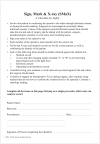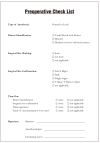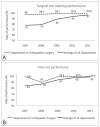Patient safety in spine surgery: regarding the wrong-site surgery
- PMID: 23508946
- PMCID: PMC3596588
- DOI: 10.4184/asj.2013.7.1.63
Patient safety in spine surgery: regarding the wrong-site surgery
Abstract
Patient safety regarding wrong site surgery has been one of the priority issues in surgical fields including that of spine care. Since the wrong-side surgery in the DM foot patient was reported on a public mass media in 1996, the wrong-site surgery issue has attracted wide public interest as regarding patient safety. Despite the many wrong-site surgery prevention campaigns in spine care such as the operate through your initial program by the Canadian Orthopaedic Association, the sign your site program by the American Academy of Orthopedic Surgeon, the sign, mark and X-ray program by the North American Spine Society, and the Universal Protocol program by the Joint Commission, the incidence of wrong-site surgery has not decreased. To prevent wrong-site surgery in spine surgeries, the spine surgeons must put patient safety first, complying with the hospital policies regarding patient safety. In the operating rooms, the surgeons need to do their best to level the hierarchy, enabling all to speak up if any patient safety concerns are noted. Changing the operating room culture is the essential part of the patient safety concerning spine surgery.
Keywords: Patient safety; Spine; Wrong-site surgery.
Conflict of interest statement
No potential conflict of interest relevant to this article was reported.
Figures




Similar articles
-
To err is human: quality and safety issues in spine care.Spine (Phila Pa 1976). 2007 May 15;32(11 Suppl):S2-8. doi: 10.1097/BRS.0b013e318053d4cd. Spine (Phila Pa 1976). 2007. PMID: 17495581 Review.
-
The occurrence of wrong-site surgery self-reported by candidates for certification by the American Board of Orthopaedic Surgery.J Bone Joint Surg Am. 2012 Jan 4;94(1):e2(1-12). doi: 10.2106/JBJS.K.00524. J Bone Joint Surg Am. 2012. PMID: 22218388
-
Achieving the National Quality Forum's "Never Events": prevention of wrong site, wrong procedure, and wrong patient operations.Ann Surg. 2007 Apr;245(4):526-32. doi: 10.1097/01.sla.0000251573.52463.d2. Ann Surg. 2007. PMID: 17414599 Free PMC article. Review.
-
Incidence of wrong-site surgery among hand surgeons.J Bone Joint Surg Am. 2003 Feb;85(2):193-7. doi: 10.2106/00004623-200302000-00002. J Bone Joint Surg Am. 2003. PMID: 12571293
-
The prevalence of wrong level surgery among spine surgeons.Spine (Phila Pa 1976). 2008 Jan 15;33(2):194-8. doi: 10.1097/BRS.0b013e31816043d1. Spine (Phila Pa 1976). 2008. PMID: 18197106
Cited by
-
Identifying a list of healthcare 'never events' to effect system change: a systematic review and narrative synthesis.BMJ Open Qual. 2023 Jun;12(2):e002264. doi: 10.1136/bmjoq-2023-002264. BMJ Open Qual. 2023. PMID: 37364940 Free PMC article.
-
From error to prevention of wrong-level spine surgery: a review.Patient Saf Surg. 2025 May 15;19(1):16. doi: 10.1186/s13037-025-00440-4. Patient Saf Surg. 2025. PMID: 40375268 Free PMC article. Review.
-
A perspective on wrong level, wrong side, and wrong site spine surgery.Surg Neurol Int. 2021 Jun 14;12:286. doi: 10.25259/SNI_402_2021. eCollection 2021. Surg Neurol Int. 2021. PMID: 34221617 Free PMC article. Review.
References
-
- Devine J, Chutkan N, Norvell DC, Dettori JR. Avoiding wrong site surgery: a systematic review. Spine (Phila Pa 1976) 2010;35:S28–S36. - PubMed
-
- Meinberg EG, Stern PJ. Incidence of wrong-site surgery among hand surgeons. J Bone Joint Surg Am. 2003;85:193–197. - PubMed
-
- Schweitzer KM, Jr, Brimmo O, May R, Parekh SG. Incidence of wrong-site surgery among foot and ankle surgeons. Foot Ankle Spec. 2011;4:10–13. - PubMed
-
- Wong DA, Herndon JH, Canale ST, et al. Medical errors in orthopaedics. Results of an AAOS member survey. J Bone Joint Surg Am. 2009;91:547–557. - PubMed
-
- Antonacci MD, Eismont FJ. Neurologic complications after lumbar spine surgery. J Am Acad Orthop Surg. 2001;9:137–145. - PubMed
LinkOut - more resources
Full Text Sources
Other Literature Sources

